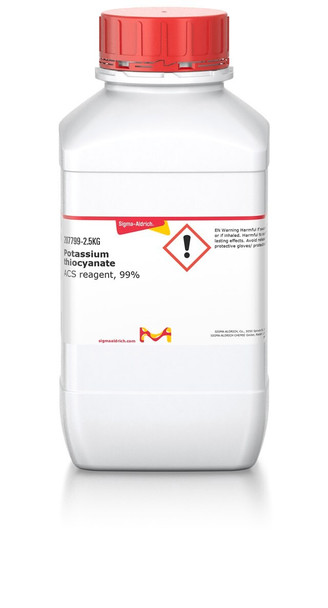Description
Potassium thiocyanate, ACS reagent, 99%
Synonym(s):
Potassium rhodanide
Linear Formula:
KSCN
CAS Number:
333-20-0
Molecular Weight:
97.18
Beilstein:
3594799
EC Number:
206-370-1
MDL number:
MFCD00011413
PubChem Substance ID:
329752022
PROPERTIES
grade
ACS reagent
Quality Level
200
Assay
99%
form
crystalline powder
impurities
Iodine consuming substances, passes test
≤0.005% insol. water
color
colorless to white
pH
5.3-8.7 (25 °C, 5%)
mp
173 °C (lit.)
anion traces
chloride (Cl-): ≤0.005%
sulfate (SO42-): ≤0.005%
cation traces
Fe: ≤2 ppm
NH4+: ≤0.003%
Na: ≤0.005%
heavy metals (as Pb): ≤5 ppm
SMILES string
[K]SC#N
InChI
1S/CHNS.K/c2-1-3;/h3H;/q;+1/p-1
InChI key
ZNNZYHKDIALBAK-UHFFFAOYSA-M
General description
Potassium thiocyanate is an inorganic potassium salt. Phase transitions in potassium thiocyanate (KSCN) have been investigated by X-ray diffraction studies. The order-disorder type transition with respect to the orientation of the thiocyanate ions was identified.[1] Its polarized infrared spectrum has been reported.[2] It participates in the ring-opening of aziridines. The reaction was carried out in the presence of sulfated zirconia to afford the corresponding β-aminothiocyanates.[3]
Application
Potassium thiocyanate (KSCN) may be used for the colorimetric quantification of intracellular iron content of the superparamagnetic iron oxide (SPIO) nanoparticles.[4]
Potassium thiocyanate may be used in the synthesis of the following:
- α-Amino nitriles from tertiary amines.[5]
- Polysubstituted 2-aminothiazoles from vinyl azides.[6]
- Benzisothiazol-3(2H)-one derivatives from o-bromobenzamides.[7]
- Diaryl thioethers from aryl halides.[8]
SAFETY INFORMATION
Pictograms
GHS05,GHS07
Signal Word
Danger
Hazard Statements
H302 + H312 + H332 - H318 - H412
Precautionary Statements
P273 - P280 - P301 + P312 - P302 + P352 + P312 - P304 + P340 + P312 - P305 + P351 + P338
Hazard Classifications
Acute Tox. 4 Dermal - Acute Tox. 4 Inhalation - Acute Tox. 4 Oral - Aquatic Chronic 3 - Eye Dam. 1
Supplementary Hazards
EUH032
Storage Class Code
13 - Non Combustible Solids
WGK
WGK 1
Flash Point(F)
Not applicable
Flash Point(C)
Not applicable





